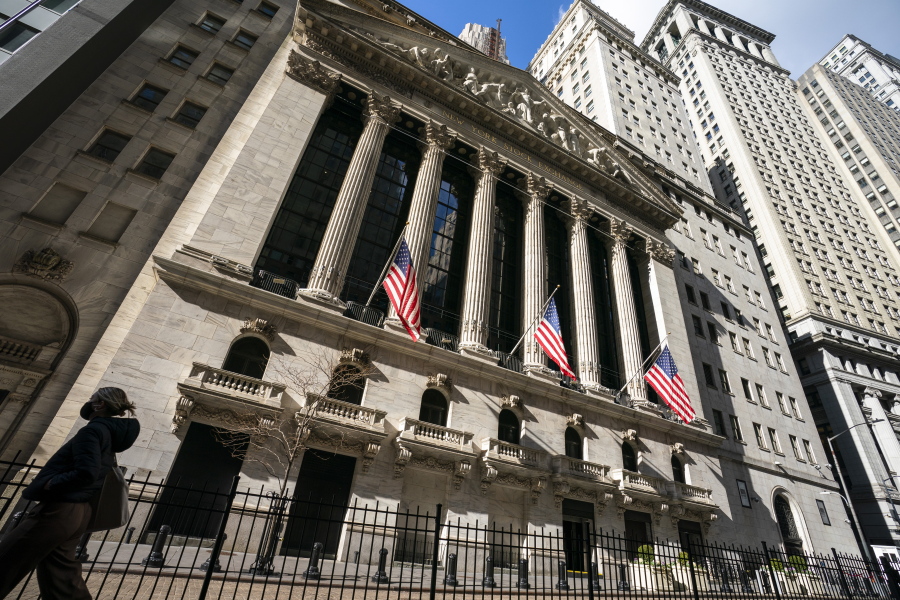NEW YORK — Markets quivered Monday amid worries about how high oil prices will go and how badly the global economy will get hit after the U.S. and allies upped the financial pressure on Russia for its invasion of Ukraine.
Stocks swung up and down several times, leaving the major indexes mixed. Investors herded into bonds in search of safety, pushing yields sharply lower, and the value of the Russian ruble plunged to a record low.
The S&P 500, which had been down as much as 1.6 percent, recouped much of its losses to finish 0.2 percent lower. The Dow Jones Industrial Average fell 0.5 percent and the Nasdaq composite rose 0.4 percent after coming back from a 1.1 percent slide.
The volatile trading followed Western allies’ move over the weekend to block some Russian banks from a key global payments system. The U.S. Treasury Department also announced new and powerful sanctions against Russia’s central bank.
The Biden administration said Germany, France, the UK, Italy, Japan, European Union and others will join the U.S. in hitting Russia’s central bank, which said the Moscow stock exchange would remain closed Monday.
Stocks on Wall Street trimmed their losses through the morning, at one point flipping to modest gains, after big tech stocks and others that benefit most from low interest rates rallied. The war in Ukraine is raising expectations that the Federal Reserve may have to take it more slowly in its campaign to raise interest rates in order to fight inflation.
Other markets showed more fear about the rising antagonism between Russia and the U.S. and its allies.
Oil prices on both sides of the Atlantic climbed more than 3 percent amid concerns about what will happen to crude supplies, because Russia is one of the world’s largest energy producers. That’s increasing the pressure on the already high inflation squeezing households around the world.
In search of safer returns, investors plowed into U.S. government bonds, which drove the yield of the 10-year Treasury down about 0.15 percentage points to 1.83 percent, its biggest drop since the omicron coronavirus variant first rattled investors. Gold rose 0.7 percent.
The gyrations are just the latest sharp swings for markets, which were relaxing in relief just on Friday, in part on thoughts that sanctions against Russia weren’t as severe as they could have been. More sharp turns are likely in the hours and days ahead given all the uncertainty about the war.
“Right now the situation is fluid and investors are looking for the next shoe to drop,” said Barry Bannister, chief equity strategist at Stifel.
The pressure on Russia isn’t coming only from governments. London-based energy giant BP said Sunday it would dump its investment in Rosneft, a Russian energy company. BP has held a nearly 20 percent stake in Rosneft since 2013, and its shares listed in London fell 3.9 percent.
The S&P 500 fell 10.71 points to 4,373.94. The Dow, which had dropped 589 points, ended down 166.15 points to 33,892.60. The Nasdaq rose 56.77 points to 13,751.40.
The Russell 2000 index of small company stocks also bounced back from an early slide, adding 7.16 points, or 0.4 percent, to 2,048.09.
Markets had already been on edge before Russia’s invasion, worried about upcoming hikes in interest rates by the Federal Reserve, which would be the first since 2018.
Fed Chair Jerome Powell is scheduled to testify before Congress later this week, where he could offer clues on the path for interest rates. A report on Friday will also show whether strength in the U.S. jobs market continued in February, which would give the Fed more leeway to raise rates.
“This situation is throwing the inflation question into a little bit of tailspin,” said Greg Bassuk, CEO of AXS Investments. “The eyes are going to be on Powell to see the extent to which the Fed believes these geopolitical events could impact their timing and extend their rate hikes.”
The Fed is caught on a narrow tightrope, needing to raise rates enough to stamp out high inflation but not by so much as to choke the economy into a recession. Higher rates also put downward pressure on all kinds of investments from stocks to cryptocurrencies.
Given the uncertainty surrounding Ukraine, investors have sharply pared back bets the Fed will raise rates in March by double the usual increase. Traders are now forecasting just a 10.4 percent chance of that, according to CME Group. A day earlier, they were pricing in a 24 percent probability.
“Expectations are that central banks are going to take a somewhat slower and more cautious approach as a result of this crisis, so that provides a positive offset for risky assets,” Jonas Golterman, senior global markets economist at Capital Economics, said in an online briefing Monday.
Energy stocks in the S&P 500 jumped 2.6 percent. Defense-related companies also gained, with Lockheed Martin up 6.7 percent.
Financial analysts say wars and other such scary geopolitical events tend to have only a temporary effect on markets, perhaps lasting weeks or months. But in the moment, fear is nevertheless still higher.
Putin’s order that Russian nuclear weapons stand at increased readiness to launch ratcheted up tensions with Europe and the United States and revived dormant fears from the Cold War era.
The Russian central bank raised its key rate to 20 percent from 9.5 percent in a desperate attempt to shore up the plummeting ruble and prevent a run on banks. The Russian currency plunged at one point plunged below 0.9 cents before climbing back to a shade above a penny, though still down nearly 15 percent.
The ruble had plunged more than 30 percent after the move to block Russian banks from the SWIFT payments system. Among other things, the sanctions are meant to crimp the Russian central bank’s access to over $600 billion in reserves and hinder its ability to support the ruble.



